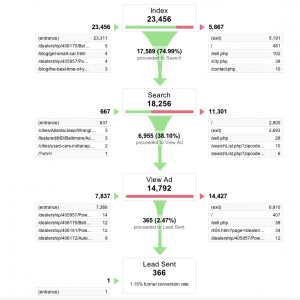10 Things To Check In Your Google Analytics
This is part 2 of a multi-part series on increasing conversions from your website traffic. If you haven’t already, you should read part one, which introduces the Infinite Conversion Loop.
The old cliché – “How do you know where you’re going, if you don’t know where you’ve been?” is especially applicable to Analytics. Before you can even hope to get a handle on increasing the conversion rate of your website, you need to make sure you’re actually tracking all of the things that will help you analyze what’s going on!

The most common problem we encounter with customers here at LunaMetrics is an incorrect or incomplete Google Analytics configuration. Here’s a checklist of a few of the things you should definitely be doing before going any further in the conversion loop.
- Is the tracking code on EVERY page (and is it functioning)? To get a complete picture of your website, you need to see how all content is performing, including legacy content, 404 pages, terms of service, you name it. If it can potentially be viewed by a person, I’d recommend putting tracking code on the page.
- Are sub-domains and cross-domains being tracked correctly? You need to be able to see how people are flowing from one domain to another to assure conversions are being attributed properly.
- Are goals configured, with funnels? Specifically, are they configured correctly? Being able to visualize funnels will be key for analysis.

- Is E-Commerce configured? All E-Commerce sites should have E-Commerce configured (obviously) to track dollar values of transactions. But really any site that can provide a concrete monetary value to an action should have this. Does a confirmed lead generation add to your E-Commerce? What about a donation?
- Is AdWords Linked? If you do any type of AdWords spending, it’s crucial that you link your account to be able to see how well these campaigns are working.
- Are Campaign tags being used consistently and efficiently? Are you even using Campaign tags in your marketing?
- Are you tracking Events? I recommend tracking any high value action as an event. If people are leaving your site for a third-party site, that should be tracked as an event. Downloading a file, clicking a drop down menu, it’s up to you to decide what actions make the most sense as events.
- Is Site Search configured? This is one of the most useful things you can do. If you have a search box on your site, more likely then not a confused visitor will do a search to find what they are looking for. If they still don’t find what they want from your search, you can guarantee this will add to your bounce rate. (On the flip side, often a really useful search box can make up for other navigational problems your site may have).
- Are you tracking Social Engagement? Today “The Net” is much more then the web. If you don’t have a social component to your site, you should consider adding some type of social sharing widget right now. Once you have that installed, it’s important to see how and where it’s being used to get a picture of your engagement. That’s where the GA Social Engagement plug-in comes in.
- Is AdSense linked? If your business relies on AdSense as a revenue, you’ll definitely want to see how it performs on your site.
It’s also recommended you update to the Asynchronous code if you are not already using it. In my experience it provides much more reliable numbers. The second question of “is it functioning” can be tested by looking at your data in GA, and also using an HTTP monitor to make sure the utm.gif is being requested on page load.
Now that you have all of this setup, next time we’ll talk about how to analyze this data (beyond page views and visitor counts!) to figure out what’s going on with your site and how you can begin to optimize. Ready to continue to part 3, find out who are These People Visiting My Website.


